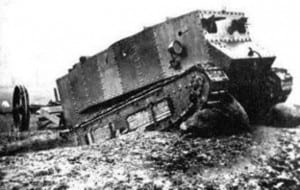“Devised performance, as contrasted with conventional theatre, results from the identification, selection and accumulation of concepts, actions, texts, places and things which are composed and orchestrated in space and time according to a set of governing aesthetics, ideologies, techniques and technologies.” ((Pearson, Mike and Shanks, Michael 2001, Theatre/Archaeology, London:Routledge, p.55))
The T.A.N.K group started with a fragment of information from the Lincoln Archives about tank test-driving on Lincoln’s West Common, and we added to our collective knowledge with other such fragments; masks the tank crews wore, the motto they had, the dangers they faced. Our first attempt at constructing a performance based on these fragments resulted in something too theatrical. The text we used at first was made up of dialogue that was too character based, and didn’t work. The focus had to be the tank’s history, not ours, if the piece was to work. We re-wrote this, but then we were unable to procure authentic-looking tank crew masks. We tried to create our own interpretations from the resources we could find. They were very stylistic and consequently jarring when put into a performance that was aiming to be more factual. Mike Pearson says “Assemblages – performance and document – are inevitably partial. Rooted in uncertainty, they all require acts of interpretation. And there is no end to what can be said about them, to how they might be interpreted.” ((Pearson, Mike and Shanks, Michael 2001, Theatre/Archaeology, London:Routledge, p.56)) This is true, but when working as a small group alongside other small groups to create one collective performance you must keep in mind whether your style of interpretation of your data compliments the rest of the complete piece.
